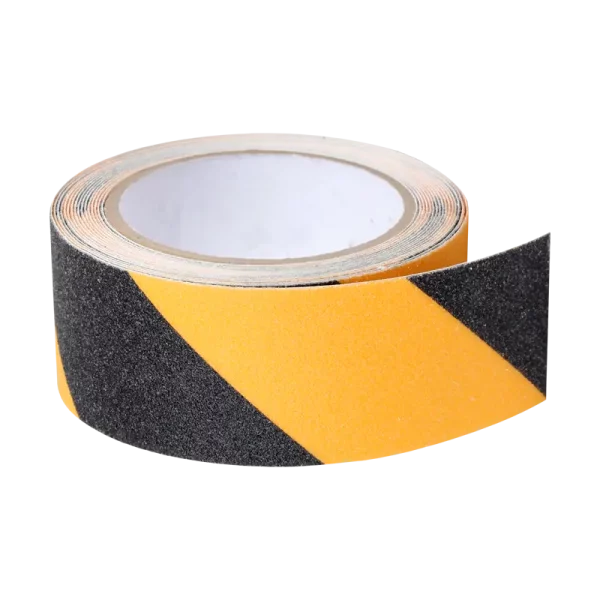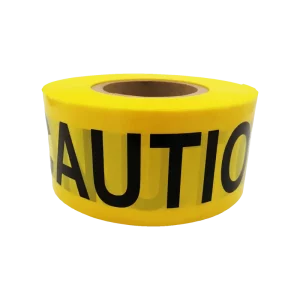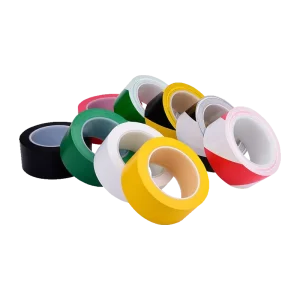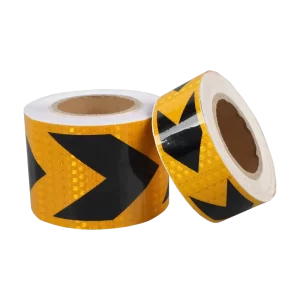1. Introduction to Warning Tape
Warning tape is a widely used safety tool made of durable materials like polyethylene (PE) and polyvinyl chloride (PVC) with high-visibility colors and sometimes text. Typically seen in colors like yellow with black stripes or red and white, warning tape serves as a clear, nonverbal signal for caution, urging people to stay away from certain areas or to remain vigilant. Whether at construction sites, event venues, or manufacturing facilities, warning tape helps maintain safety, order, and compliance with regulatory standards. In emergency situations, it can be critical in directing people away from potential hazards.
Warning tape is effective not only for its visual deterrent but also for its flexibility. Easily applied and removed, it is an affordable solution for both temporary and semi-permanent applications. It can be used both indoors and outdoors, with various types designed to withstand different environmental conditions like wind, rain, and sunlight.
2. Types of Warning Tape
Warning tape comes in several varieties, differentiated by their colors, materials, and intended applications. Here’s an overview of the primary types:
- Yellow and Black Tape: This is the most commonly recognized warning tape, typically used to signify general physical hazards at construction sites, warehouses, or industrial zones. The bright color combination enhances visibility, while the black stripes emphasize caution.
- Red and White Tape: Used to designate areas where access is restricted due to more severe hazards. In industries such as fire prevention, this color combination can signify the presence of firefighting equipment or zones where fire safety protocols must be strictly followed.
- Blue and White Tape: Less commonly used, blue and white tape often designates areas with specific safety regulations, such as medical zones or places with chemical storage.
- Barrier Tape: Made from highly durable materials, barrier tape is specifically designed to be weather-resistant and ideal for outdoor use, particularly in construction and event management. Barrier tape may come in colors like orange and red and is thicker than other types, with added tensile strength to withstand harsh conditions.
These types of tape are typically made from polyethylene (PE) or polyvinyl chloride (PVC), as these materials are weather-resistant, flexible, and suitable for outdoor and indoor use. UV-resistant tapes are especially valuable in outdoor applications, as they prevent fading or degradation when exposed to sunlight.
3. Common Applications of Warning Tape
Warning tape is essential in a variety of settings, particularly in public and high-traffic areas where safety and access control are critical. Below are some of the most common applications:
- Construction Sites: Warning tape is a fundamental safety tool at construction sites, where it is used to section off areas under active work, such as areas with heavy machinery, excavation, or scaffolding. This helps prevent unauthorized access and keeps workers safe.
- Industrial Facilities: In factories and warehouses, warning tape marks pathways for equipment, walking paths, and restricted areas, helping to maintain order and prevent accidents. For example, it can mark forklift zones, loading areas, and places where specific safety gear is required.
- Event Management: Outdoor events use warning tape to create temporary barriers, guide attendees, and designate off-limit areas, helping with crowd control. For example, event organizers may use warning tape to section off stages, VIP areas, or emergency exits.
- Crime and Accident Scenes: Law enforcement agencies use specific types of caution tape to mark off crime scenes and accident sites, ensuring evidence protection and keeping bystanders at a safe distance. This highly visible tape is essential for maintaining order and aiding investigations.
Anti slip warning tape
Durable anti-slip tape designed to enhance traction and prevent slipping accidents in various environments.
This adhesive anti-slip non-skid abrasive safety track tape is engineered for both indoor and outdoor use, featuring a high-traction surface that ensures safety in high-risk areas. Made from durable PVC, this tape is waterproof and resistant to chemicals and oils, making it ideal for diverse applications.
Adhesive Acrylic
Adhesive Side Single Sided
Adhesive Type Pressure Sensitive, Water Activated
Design Printing No printing
Material PVC film/PET film/aluminum foil/PP paper
Feature Waterproof
Use Warning
Click for details
4. Benefits and Importance of Warning Tape
Warning tape’s significance lies in its ability to provide a quick, easy-to-understand signal that enhances safety in potentially hazardous areas. Here are some of the primary benefits:
- Enhanced Safety: Warning tape clearly indicates where people should or should not go, reducing the risk of accidents. This is crucial in industries like construction, manufacturing, and public safety.
- Cost-Effectiveness: Compared to physical barriers like gates or fences, warning tape is more affordable, especially for temporary applications. It is also easy to replace or move as needed.
- Regulatory Compliance: In many industries, using warning tape is part of compliance with safety regulations. Proper marking of hazardous areas can help companies meet safety standards, potentially reducing liability.
- Ease of Use and Flexibility: Warning tape is quick and easy to apply or remove, making it suitable for situations that require temporary setup. It also adapts to various surfaces, from fences to floors, without causing damage when removed.
- Public Awareness: Warning tape instantly conveys an understanding of restricted or hazardous areas to the general public, preventing accidental trespass and promoting safety.
5. How to Choose the Right Warning Tape
Choosing the correct warning tape depends on the environment in which it will be used. Here are some key factors to consider:
- Visibility: Bright, contrasting colors are essential for high-traffic areas or places with poor lighting. Some tapes even include reflective elements to increase visibility at night.
- Material and Durability: For outdoor use, UV-resistant and weatherproof materials like polyethylene or PVC are essential, as these will withstand sun, wind, and rain. Indoor applications may require less robust materials, depending on the duration and traffic level.
- Adhesive Strength: For high-foot-traffic areas or surfaces subject to significant wear, choose warning tapes with stronger adhesive to ensure they stay in place.
- Compliance Requirements: In certain industries, specific tape colors or markings are required to comply with safety standards, so it’s essential to ensure compliance with local or industry regulations.
6. Tips for Effective Usage
To ensure that warning tape is used effectively, follow these guidelines:
- Placement: Place the tape at visible, eye-level heights or in clear line-of-sight areas where it won’t be obstructed. Avoid placing tape on dusty or uneven surfaces, as this may reduce adhesive strength.
- Secure Application: For temporary barriers outdoors, use stakes or cones to secure the tape and prevent wind from blowing it away. Indoors, affix the tape directly to floors or walls using durable adhesive.
- Regular Maintenance: Warning tape may wear down over time, particularly in outdoor settings. Regularly check and replace faded or damaged tape to ensure continued visibility and effectiveness.
- Clear Messaging: Use warning tape with simple, bold wording to convey specific instructions or warnings. Common phrases like “CAUTION” or “DO NOT ENTER” are clear and easy to understand.
7. Conclusion
Warning tape has become a vital tool in maintaining public and workplace safety across diverse industries. Its ease of application, low cost, and effectiveness in promoting caution make it indispensable for organizations and individuals alike. With new materials and design enhancements, warning tape continues to evolve, offering increased durability and visibility for a wide range of applications. Whether it’s marking a construction zone or guiding event attendees, warning tape remains a simple yet powerful method for improving safety and minimizing risks.
By choosing the right type of warning tape and following best practices for application and maintenance, companies and individuals can better protect workers, the public, and their property. With continued innovation, the role of warning tape in safety protocols will only expand, ensuring a safer environment for all.

Products
Rich variety of adhesive tape





